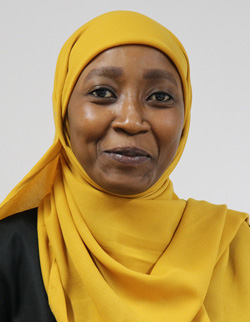icipe Governing Council Awards 2019
During its Annual General Meeting held in Addis Ababa, Ethiopia, in November 2019, the icipe Governing Council, that consists of globally renowned scientists, honoured six outstanding postgraduate scholars, currently undertaking their research at the Centre.
Best published science paper by an icipe scholar

Olabimpe Yewande Olaide (PhD Scholar)
icipe Mentor – Dr. Baldwyn Torto
Paper: Olaide O.Y., Tchouassi D.P., Yusuf A.A., Pirk C.W.W., Masiga D.K., Saini R.K. and Torto B. (2019) Zebra skin odor repels the savannah tsetse fly, Glossina pallidipes (Diptera:Glossinidae). PLOS Neglected Tropical Diseases 13(6), e0007460. https://doi.org/10.1371/journal.pntd.0007460 IF 4.487
Contribution to Science: The control of tsetse flies, vectors of human and animal African trypanosomosis, represents a sustainable approach in the integrated management of this devastating disease. Previously, vector control measures have heavily depended on trypanocides which are expensive and not sustainable. However, recent research has focused on interfering with tsetse-host contacts using repellents. Despite the diverse wildlife species occupying tsetse habitat, certain vertebrates such as waterbuck and zebra are not preferred for blood feeding. Understanding the semiochemical basis for these feeding preferences, particularly the repellent chemicals responsible, can provide leads to minimize vector-host contacts and control trypanosomosis transmission in human and livestock. Therefore, our research focused on examining zebra, a non-preferred host, for potent repellents for the savannah tsetse flies, Glossina pallidipes.
Until now, the avoidance behaviour of tsetse flies to zebra has been mostly linked to its elegantly striped pelage with no consideration for the possible contribution of repellent chemicals emanating from its skin. This study is the first to establish the contribution of skin odours of zebra to this avoidance behaviour of the tsetse fly. Using a combination of field-based behavioural experiments and chemical analyses, we show that certain ketone components of zebra skin odour are responsible for the avoidance and we formulated a new three-component tsetse repellent blend comprising 6-methyl-5-hepten-2-one, acetophenone and geranyl acetone. The efficacy of this new repellent blend compares favorably with the existing four-component repellent blend identified from waterbuck (WRC), and could offer a cheaper yet potent alternative.
This study showcases a paradigm shift establishing the contribution of odour cues from zebra skin to its avoidance by tsetse flies. The same approach can be utilised for other blood feeding arthropods for a better understanding of their chemical ecology and innovations towards their control. The new repellent blend identified and formulated in this study can be used in repellent collars and integrated into the management toolbox of animal African trypanosomosis targeting the vectors and can also be explored for the protection of humans. Such interventions are cost-effective, easy-to-use, sustainable, environment-friendly and mobile, making it suitable for African pastoralists as they graze their livestock in tsetse infested areas. Potential offshoots from this are improved animal health, increased milk and meat offtake, increased land cultivation using drought animals, increased yield and income, and food and nutrition security. These will greatly boost the livestock and agricultural production sectors which constitute the backbone of the African economy but face severe challenges due to the menace of tsetse and trypanosomosis and make the first three sustainable development goals easier to achieve in Africa.
Funding: Olaide.Y.O was supported by a German Academic Exchange Service (DAAD) in-region postgraduate scholarship and registered for her PhD degree at the University of Pretoria, South Africa. We gratefully acknowledge the financial support for this research by the following organizations and agencies: the European Union’s Integrated Biological Control Applied Research Programme – tsetse repellent component (EU-IBCARP tsetse) awarded to icipe, and grant number (IBCARP DCI-FOOD/2014/346-739); UK’s Department for International Development (DFID); Swedish International Development Cooperation Agency (Sida); the Swiss Agency for Development and Cooperation (SDC); and the Kenyan Government. The views expressed herein do not necessarily reflect the official opinion of the donors. The funders had no role in study design, data collection and analysis, decision to publish, or preparation of the manuscript.
University: The scholar is registered at University of Pretoria, South Africa

Bernard Steve Soh Baleba (PhD Scholar)
icipe Mentor – Dr. Merid Getahun
Paper: Baleba S.B.S., Torto B., Masiga D., Weldon C.W. and Getahun M. (2019) Egg-laying decisions based on olfactory cues enhance offspring fitness in Stomoxys calcitrans L. (Diptera: Muscidae). Scientific Reports 9, Article number 3850. https://doi.org/10.1038/s41598-019-40479-9 IF 4.525
Contribution to science: Oviposition decisions are a prominent example of behaviour directly affecting the fitness, abundance, distribution, and population dynamics of holometabolous insects. As the egg stage is immobile and most adult insects do not practice maternal care, gravid females need to lay eggs on a substrate that maximises the fitness of their offspring. To select an appropriate breeding site, gravid females are mostly guided by chemical cues. In the context of insect pest management, once identified, such cues can significantly reduce the level of pest infestation when associated with a trapping device. The stable fly, Stomoxys calcitrans, is a cosmopolitan haematophagous insect that transmits several pathogens (virus, bacteria, protozoa and helminths) to livestock, which causes losses in production and negatively affects human communities relying on the affected animals. Gravid female S. calcitrans use vertebrate herbivore dung for oviposition. However, there was a scarcity of information on the olfactory cues that govern oviposition site selection and their possible use in a control system. To unravel this, we used an ensemble of creative experimental approaches encompassing oviposition behaviour bioassays, analytic chemistry (headspace volatile collection and gas chromatography linked with mass spectrometry), a machine learning algorithm (Random Forest classification), and field trapping trials. We found that among all the herbivore dung types presented, gravid female S. calcitrans oviposited more on donkey and sheep dung. We showed that this preference was related to the good nutritional value of these substrates that consequently led to the best performance of S. calcitrans offspring. Furthermore, we identified β-citronellene and (R)-(-)-carvone, from donkey and sheep dung, respectively, as the olfactory cues responsible for observed preference-performance behaviour. In the laboratory, β-citronellene and carvone elicited the strongest oviposition behaviour in S. calcitrans. We confirmed this in the field by showing that traps baited with these compounds also caught more gravid S. calcitrans, making these molecules two potential attractants for S. calcitrans.
Funding: This work was supported by the IBCARP camel, grant no. DCI-FOOD/2014/ 346–739 - mainly by European Union. We also gratefully acknowledge the financial support for this research by the following organizations and agencies: Swedish International Development Cooperation Agency (Sida); UK Department for International Development (DFID); the Swiss Agency for Development and Cooperation (SDC); and the Kenyan Government. The views expressed herein do not necessarily reflect the official opinion of the donors. The Deutscher Akademischer Austauschdienst (DAAD) provided Steve B. S. Baleba with a doctoral scholarship through the icipe ARPPIS-DAAD scholarship programme. We are grateful to the Max Planck Institute for Chemical Ecology for providing us with some standard chemicals. The funders had no role in study design, data collection and interpretation, or the decision to submit the work for publication.
University: The scholar is registered at the Department of Zoology and Entomology, University of Pretoria, Private Bag X20, Hatfield, 0028, South Africa


Hilaire Kpongbe (PhD Scholar)
icipe Mentor - Dr. Baldwyn Torto
Paper: Kpongbe H., Van Den Berg J., Khamis F., Tamò M. and Torto B. (2019) Isopentyl butanoate: Aggregation pheromone of the brown spiny bug, Clavigralla tomentosicollis, (Hemiptera: Coreidae), and kairomone for the egg parasitoid Gryon sp. (Hymenoptera: Scelionidae). Journal of Chemical Ecology, PMID: 31209625 DOI: 10.1007/s10886-019-01081-5 IF 3.151
Contribution to science: This study investigated the chemical communication among sexes of Clavigralla tomentosicollis, a devastating pest of many leguminous crops throughout most of Africa including cowpea, French bean and pigeon pea. Yield losses of up to 100% attributed to Clavigralla spp. (Hemiptera: Coreidae) infestation has been reported besides direct feeding damage to pods contributing to loss of seed viability (65-85%). The goal was to develop an eco-friendly approach to controlling this pest using semiochemicals. The study combined laboratory behavioural assays with chemical analytical techniques (GC-EAD, GC-MS) to identify the aggregation pheromone of this pest and assess its interaction with its parasitoid, Gryon sp. Key findings of the study include: (i) Attraction of male volatiles to both sexes of the pest; (ii) Identification of a male-produced aggregation pheromone, isopentyl butanoate, which aggregated both sexes of the pest; and (iii) The pest’s parasitoid Gryon sp. was attracted to the pheromone.
Although olfaction has been reported to be involved in the aggregation behaviour of C. tomentosicollis, the nature and identity of the compound(s) have remained elusive. Here, by combining a series of bioassay-guided assays and state-of-the-art chemical analyses, this study identified for the first time, isopentyl butanoate, as an aggregation pheromone for both sexes of C. tomentosicollis. Furthermore, beyond the role of Gryon sp. as an egg parasitoid used in the biological control of C. tomentosicollis, the present study highlights the kairomonal effect of the identified pheromone on this parasitoid.
The study showed that olfaction plays a key role in the aggregation of C. tomentosicollis and host finding of its parasitoid. Specifically, the study presents new knowledge on the chemical ecology of the pest C. tomentosicollis but also in the host location and selection of its parasitoid, Gryon sp. The results, therefore, provide the fundamental baseline information required for field evaluations of isopentyl butanoate in the management of C. tomentosicollis and open areas for further research. The present study identified a semiochemical (isopentyl butanoate), which will contribute in the development of novel biological control strategies for the management of C. tomentosicollis. The objectives align with icipe’s research priorities in the Plant Health Theme to contribute to sustainably manage biotic stresses including infestation by crop pests, by reducing the use of chemical pesticide, and hence improving human, animal and environmental health while improving livelihoods of farming households.
Isopentyl butanoate reported in this study could be exploited in various ways in the efficient management of Clavigralla spp. Because pheromones are species-specific, the compound can be integrated into the pest management in an ‘attract and kill’ system for the pest. Alternatively, the compound could be sprayed/dispensed on legume plantations to increase Gryon spp presence in the field and activities and thus enhance parasitism on the pest. These potential control methods will increase legume production, and therefore improve the incomes and assure food security especially for small-holder farmers as well as human, animal and environmental health.
Funding: Hilaire Kpongbe was supported by a German Academic Exchange Service (DAAD) In-Region Postgraduate Scholarship. Financial support for this research was provided by UK’s Department for International Development (DFID), Swedish International Development Cooperation Agency (Sida), the Swiss Agency for Development and Cooperation (SDC), Federal Democratic Republic of Ethiopia; and the Kenyan Government. The funders had no role in study design, data collection and interpretation, or the decision to submit the work for publication.
University: The scholar was registered at, Unit for Environmental Sciences and Management, North-West University, Potchefstroom, South Africa.
Best science poster by an icipe scholar

Lilian Mbaisi (MSc. Scholar)
Poster: A novel microsporidian blocks Plasmodium falciparum transmission in Anopheles arabiensis mosquitoes
Supervisors: Enock Mararo1, Joseph Oundo1, Edward E. Makhulu1, Hellen Butungi1, Maria Vittoria Mancini2, Victor Mobegi3, Jordan Jabara1, Steven P. Sinkins2, Jeremy K. Herren1,2
1International Centre of Insect Physiology and Ecology (icipe), Kasarani, Nairobi, Kenya;
2 MRC-University of Glasgow Centre for Virus Research, Glasgow, UK; 3Centre for Biotechnology and Bioinformatics (CEBIB), University of Nairobi, Nairobi, Kenya.
Brief Summary: Global malaria control approaches have been majorly compromised by the evolution of insecticide-resistant mosquitos and the drastic change in vector biting behavior1. Research has currently shifted focus to developing more sustainable tools such as the development of transgenic mosquitoes and the use of mosquito symbionts to control vector population2 and Plasmodium transmission3-4. The SymbioVector team, led by Dr. Jeremy Herren, works on the molecular characterization of microbes from the Anopheles mosquito to determine their Plasmodium transmission-blocking capacity. In line with this, this study reports the isolation of a novel endosymbiont within Anopheles arabiensis mosquitoes in Kenya. This symbiont was classified as a microsporidian of terrestrial origin. Fluorescence microscopy was used to show tissue localization and transmission routes among successive generations. Moreover, we demonstrate that Microsporidia MB has a highly efficient vertical transmission rate making it highly sustainable from one generation to the next. More importantly, this work illustrates a negative correlation between Plasmodium and the symbiont both in field and laboratory-colonized mosquitoes using Plasmodium membrane-feeding assays making it a plausible transmission-blocking agent.
- WHO-coordinated Multi-country Evaluation, ‘Implications of Insecticide Resistance for Malaria Vector Control’, 2016.
- Toshiyuki Harumoto et al. ‘Male-Killing Symbiont Damages Host’s Dosage-Compensated Sex Chromosome to Induce Embryonic Apoptosis.’, Nature Communications, 7 (2016)
- Anne Boissière et al. ‘Midgut Microbiota of the Malaria Mosquito Vector Anopheles Gambiae and Interactions with Plasmodium falciparum Infection’, PLoS Pathogens, 8.5 (2012), e1002742
- Grant L. Hughes et al. Wolbachia Infections Are Virulent and Inhibit the Human Malaria Parasite Plasmodium falciparum in Anopheles gambiae’, PLoS Pathogens, 7.5 (2011), 3–10
Funding: This work was supported by the Wellcome Trust [107372, 202888], the Scottish Research Council, the Swiss National Science Foundation [P2ELP3_151932], the R. Geigy Foundation, the UK’s Department for International Development (DFID); Swedish International Development Cooperation Agency (Sida); the Swiss Agency for Development and Cooperation (SDC); Federal Democratic Republic of Ethiopia and the Kenyan Government. The views expressed herein do not necessarily reflect the official opinion of the donors.
University: The scholar is registered at Centre for Biotechnology and Bioinformatics (CEBIB), University of Nairobi, Nairobi, Kenya.


Pascal Osa Aigbedion-Atalor (PhD Scholar)
Poster title: Unravelling and ameliorating the impacts of Tuta absoluta (Meyrick) in East Africa: spread, socio-ecological impacts, and potential of a newly-imported parasitoid.
Supervisors: Martin P. Hill2, Myron P. Zalucki3, Ramasamy Srinivasan4, Sunday Ekesi1, Samira Abuelgasim Mohamed1
1International Centre of Insect Physiology and Ecology (icipe), P.O. Box 30772-00100 Nairobi, Kenya; 2Centre for Biological Control, Department of Zoology and Entomology, Rhodes University, P.O. Box 94, Grahamstown, 6140, South Africa; 3School of Biological Sciences, The University of Queensland, 4072, Australia, 4World Vegetable Center, 60 Yi Ming Liao, Shanhua, Tainan 74151, Taiwan, Republic of China
Brief Summary: In East Africa, tomato production is a fundamental driver of sustainable livelihoods and food security, especially for small-scale farmers and traders in impoverished rural communities. However, the invasion and current widespread proliferation of the South America tomato pinworm, Tuta absoluta (Meyrick) (Lepidoptera: Gelechiidae), represent a serious threat to its production. Since its first detection in Sudan in 2010, T. absoluta has spread throughout East Africa with devastating impacts on tomato production. In Kenya, for example, the average seasonal loss caused by T. absoluta is currently estimated at 114,000 tonnes, equating to USD 59.3 million. In encompassing its direct impacts – yield loss – in tomato, this pest has significantly increased the production and purchasing costs of tomato and concomitantly caused serious loss of tomato-dependent livelihoods, particularly among women; who constitute over 60% of the labour force along the value chain. Furthermore, to manage its devastating impacts, tomato-growers are reliant on the use of synthetic insecticides for the control of this pest. This, however, has led to an alarming threefold increase in the application frequency post-invasion of T. absoluta in East Africa. Indeed, there is some evidence, albeit anecdotal, that the significant increase in the use of synthetic insecticides has led to the development of resistance in this pest, making its management a more complex matter. To mitigate its impacts, the International Centre of Insect Physiology and Ecology in Kenya, in collaboration with the International Potato Centre in Peru, imported a solitary larval endoparasitoid – Dolichogenidea gelechiidivoris (Marsh) (Hymenoptera: Braconidae) – of T. absoluta into Kenya. Results of the pre-release evaluation of D. gelechiidivoris, under quarantine environmental conditions, showed that it can parasitize and complete its development in all four larval instars of T. absoluta. All four host larvae instars produced reproductively viable progeny, and females emerged with high egg load. Dolichogenidea gelechiidivoris is, therefore, a potential biological control candidate of T. absoluta in Africa. Following further evaluations, it will be released in Kenya and beyond.
Funding: This study was funded by the Federal Ministry for Economic Cooperation and Development (GIZ Project ID: 16.7860.6-001.00) Germany, through the World Vegetable Center, Taiwan. Funding was also provided by the Biovision foundation Tuta IPM project (project ID: BV DPP-012/2019-2021). icipe core funding provided by UK Aid from the UK Government, Swedish International Development Cooperation Agency (Sida), the Swiss Agency for Development and Cooperation (SDC), Government of the Federal Democratic Republic of Ethiopia, and the Kenyan Government. The scholar is supported by a German Academic Exchange Service (DAAD) in-region postgraduate scholarship. The views expressed herein do not necessarily reflect the official opinion of the donors.
University: The scholar is registered at Rhodes University, South Africa.


Iman Brema Hassaballa (PhD Scholar)
Poster Title: Exploring sand fly plant feeding behaviour for development of nectar- based vector control strategies
Supervisors: David P. Tchouassi¹, Catherine L. Sole ² and Baldwyn Torto¹
¹International Centre of Insect Physiology and Ecology (icipe), Kenya; ²University of Pretoria, South Africa; ³University of Kordofan, Sudan
Brief Summary: Phlebotomine sand flies are vectors of pathogenic agents of several zoonotic and human diseases such as leishmaniasis, which is caused by a protozoan in the genus Leishmania. Control of leishmaniasis largely relies on chemotherapy but available drugs are toxic and expensive, and also there is no vaccine in existence. Understanding the bio-ecology, and behavior of sand flies is proposed as a possible avenue to developing alternative control measures. The plant feeding behavior of sand flies in a leishmaniasis endemic area of Kenya is explored for potential development of nectar-based vector control strategies. The present study aimed to determine the extent of plant sugar feeding in the sand fly species in their natural habitat. The study was conducted in Rabai village, in the Rift Valley Province of Kenya. We applied biochemical and molecular methods to i) compare the extent of plant feeding among different sand fly species/sexes belonging to Sergentomyia and Phlebotomus genera from different habitat, ii) identify specific plants that sand flies fed upon in nature, and iii) identify signature cues mediating sand fly attraction to the identified plants. We found variation in the proportion of sugar fed males and females with generally no significant difference (p ≤ 0.05) within sand fly species. In addition, our study shows that identified plant species that sand flies fed upon in nature mainly belong to the family Fabaceae. It is recommended that chemical profiling of host plant odors with specific volatile organic compounds that can be developed into lures for surveillance of sand fly vectors of Leishmania parasites and phleboviruses should be further investigated.
Funding: We gratefully acknowledge the financial support for this research by the following organisations and agencies: European Union; icipe core funding provided by UK Aid from the UK Government, Swedish International Development Cooperation Agency (Sida), the Swiss Agency for Development and Cooperation (SDC), Government of the Federal Democratic Republic of Ethiopia, and the Kenyan Government. The scholar is supported by a German Academic Exchange Service (DAAD) in-region postgraduate scholarship. The views expressed herein do not necessarily reflect the official opinion of the donors.
University: The scholar is registered at University of Pretoria, South Africa.


